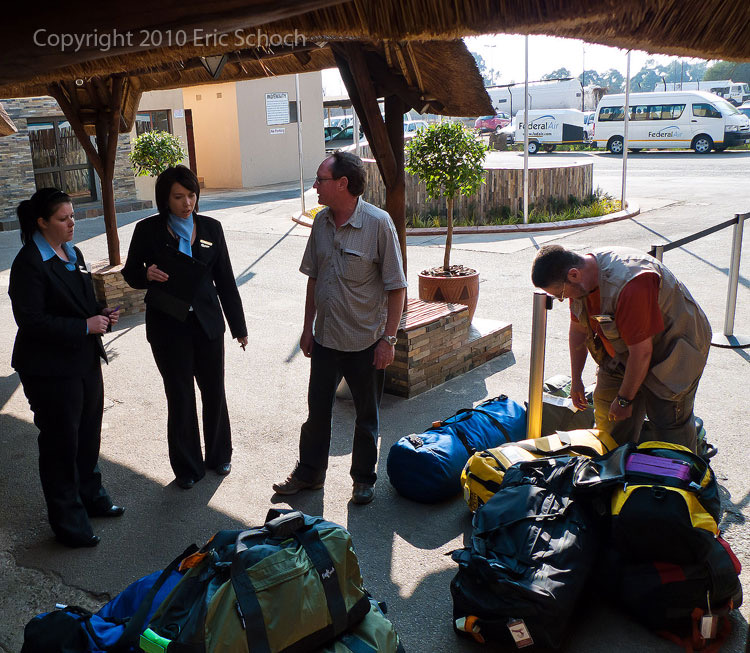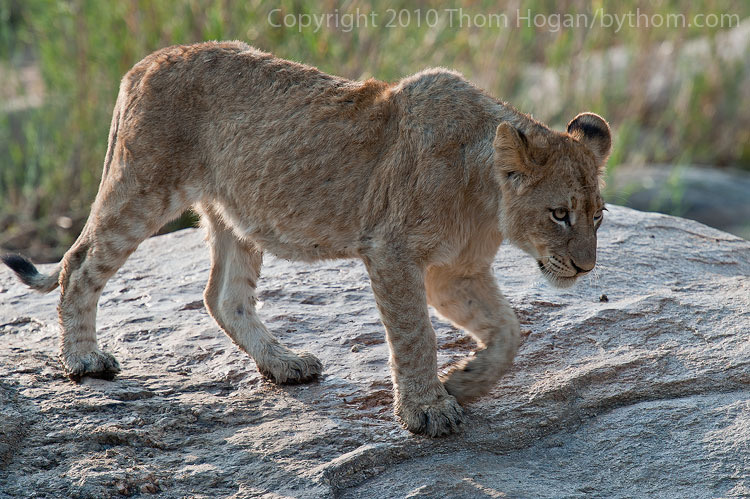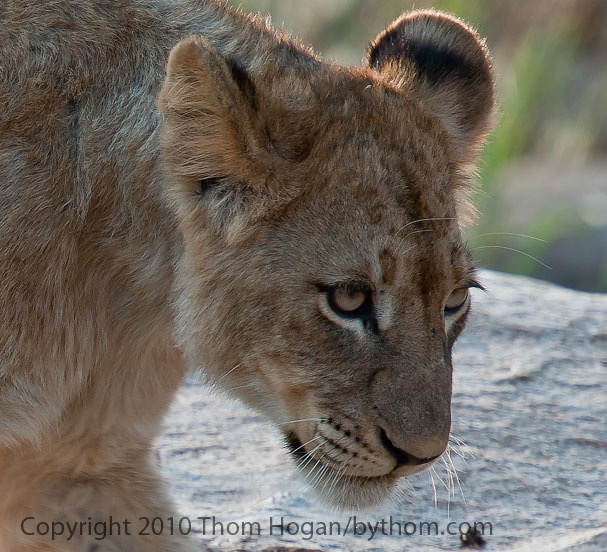Aug 29—Today we moved to the grand finale of the South Africa workshop: the Sabi Sands preserves at the edge of Kruger National Park. Sabi Sands and Timbavarti are the names of two larger areas that are adjacent to Kruger, but within each are many individual areas. In Sabi Sands, there are Kirkman's Kamp, Mala Mala, Londolozi, Sabi Sabi, and several other camps. We're headed to Kirkman's Kamp, which I think is best of the bunch, though perhaps not quite as upscale as some, like Londolozi.
These private reserves are a unique wildlife experience. Kruger National Park itself is a huge protected area for wildlife. The private reserves border the entire West edge of Kruger, and as there is no fence between the two, the animals don't know (or care) whether they're in Kruger or a private reserve. There's one difference as far as wildlife photographers are concerned, though: the private reserves provide the some of the best wildlife experience on the planet. As most of you know, I don't often write in superlatives. "Some of the best" is exactly what I mean, though. So I'd better explain.
Several things make the private reserves unique and remarkable for a wildlife photographer:
- The animals. I've already noted that there's no fence between Kruger and the preserves. That makes the entire area (Kruger+preserves) one of the biggest protected ecosystems on the planet. Within the park itself the park service has cracked down on poaching, and within the private reserves, a poacher simply wouldn't have much of a chance. Not to say that there's no pouching, at all, but in the private reserves especially, the owners know that their livelihood is dependent upon the animals, and they are vigilant at levels not matched many other places. So, for instance, you find rhino in the preserves. As you might have noticed when I wrote about the Cheetah Center, they've raised animals and placed them in the preserves, so the other thing that's happened is that the preserves have been active in trying to promote DNA diversity and replacement of animals that were once endangered. But to put it in perspective, there's no other place in Africa where I'd ever guarantee that workshop participants see and photograph the Big Five (lion, leopard, elephant, buffalo, rhino). In many of the private preserves, I would.
- The land. Many of the preserves are big. Kirkman's Kamp has 140,000 hectares of their own, and also drives on one adjacent private property with permission (you can also cross into Kruger, but there regulations and permit fees start to intrude; more on that in a moment). The good camps have superb locations, too. In Sabi Sands, most of the great camps are on the Sands River. Remember, animals need water. There aren't a lot of water sources available, so being on or very near the river is an advantage, as you can better predict animal behaviors. And speaking of animal behaviors:
- The knowledge. The guides on the preserves know their preserve. Since they are driving through the same areas daily, and since they're in constant radio contact with all the others driving on the preserve, they quickly learn behavioral patterns of the animals using their land. They know where the dens are, they know the history of pretty much every carnivore you'll see (and some of the others, like elephants and rhino). They know most of the animal's territories. They know when a big cat has eaten and when it hasn't. They know were many of the key animals are at given moment in time.
- The regulations. You're on private land, and the owners set the regulations, not the park service. And as far as I'm concerned, they've set very reasonable ones that are highly favorable to wildlife photographers. First, they drive off-road here. Most national parks in Africa do not allow off-road travel, including Kruger itself. And I truly mean off-road. At times I've been driven through terrain on the preserves I'd be damned if I'd ever want to walk through as it was so thick with brush. This off-roading doesn't come often; it comes opportunistically. And they have a lot of small sub-regulations you probably won't notice, as they're trying not to establish new roads and paths on their land, but instead try to move through the land in ways where the land will simply heal itself. And it does. You'll be hard-pressed to tell where vehicles have been versus where animals have been (animals create paths, too ;~). But just being able to go-off road isn't the only good regulation for photographers. Another that's particularly interesting is the maximum-vehicles-per-siting. First, no vehicles are allowed at newly born animal dens. Early on in a new cat's life an off-duty guide/driver will take a vehicle out to where it is and stay there for a very short period of time without passengers. Once the animal is acclimated to that, a single vehicle will be allowed with clients if the cub's mother or father are present. Past a certain age, they'll allow two vehicles. And for full-grown animals, a maximum of three vehicles per animal sighting are allowed. Thus, you don't get the 24 Land Rover pileups that you do in the Serengeti or other places in Africa, and the animals don't get stressed by the vehicles (sometimes because they're literally surrounded). The preserves have worked out a communication system that "manages" sightings, and this, too, is to the advantage of the wildlife photographer: the radio contact between vehicles means that your guide pretty much knows where everything is being found on a given day, and what's available to go photograph. You might worry that you won't have enough time at a sighting if only three vehicles at a time can be there, but don't. The non-photography safaris tend to come and go pretty fast, even on things like the big cats, so I've never felt rushed or unable to get the photos I've wanted on the preserves. The one possible exception is very young cubs (that one vehicle limit), but even there what usually happens is you go in and photograph for 15-30 minutes (and remember, you're up close).
So: we've got all of the major animals of the other African parks, can drive right up to them even when they're off road, and our guides pretty much know where they are (or should be) much of the time. That's all a wildlife photographer can ask for, isn't it?
But first we have to get to Sabi Sands. And that involves yet another plane flight. Kirkman's is very near the Skukuza airstrip in Kruger National Park, and thus we fly from Jo-berg to Skukuza on a small charter plane. Unfortunately, at the airport we found that the weight limits have changed recently (now 20kg per person, which barely covers most of our camera bags; and yes, they do weigh everything), so when we arrived at our charter, our first problem was negotiating a weight penalty. To which there wasn't much negotiation as it turned out. Here's Lanz and I not negotiating with the Federal Air staff:

For others flying to Kirkman's from Jo-berg, just be aware that if the plane you're on is packed full, you might not get all your gear onto your flight, and because these are charter type flights, they don't always occur multiple times a day--the bag you left behind may fly on another flight (after paying your weight penalty ;~) and might not show up for another day. So, do as I say, not as I did: pack light. Had we known about the change in weight policy, we could have mitigated some of our weight penalty (I'm pretty sure we'd have still have been over). But that's Africa, and I'm a bit used to it. Sometimes you get hit by the weight problem, sometimes you don't. Personally, I just wish that there'd be more continuity and clear policies on overweight costs. If I can plan for something, I can deal with it. If I can't, it just adds to the logistical frustrations of such long and involved trips.
Can you drive to Kirkman's Kamp? Yes, it's about a six hour drive from Jo-berg. The last six miles is dirt road, and the Nelspruit to Kirkman's Kamp part of the trip is a little tricky to navigate, so make sure you understand the directions and are keeping your eye peeled for the key turns. You'll also have to pay a small entrance fee into the preserves at the Shaw's Gate.
But we got everyone and everything onto the plane. Yea! And so at lunch we found ourselves met at the airport by our drivers and trackers for the short drive to camp, where it was almost time for lunch. So we settled into our rooms (see below) and then headed to lunch.

After lunch we had our first game drive. Since we've got several days of game drives ahead of us (several weeks if you include Botswana), I'll be spreading out some of things I'm going to say about game drives over several days' blog entries. The thing you need to know right now is that we've got two vehicles for this particular workshop, with everyone having a row of seating to themselves (mostly; I'm in the front seat with the driver, Vince is on the back seat with the tracker). Everyone stays in the same vehicle for the duration (so that the guides know what people have seen and what they've told them so they don't repeat themselves). Everyone except for Lanz and I, that is, who swap vehicles every day. That's so every student gets an equal share of me and Lanz for instruction during the drives. Today I'm with Tony, Robert, and Vince, with Anton as our driver/guide and Robert as our tracker. Our first request from the students: lions.

Our first stop of the workshop: lions. Yep, we didn't get very far. Basically, we drove down off the hill from the lodge to the river and found the lions along the river sitting on the rocks. Kind of hard to miss. Well, that was easy. One of the Big Five out of the way within a couple of minutes work ;~)

For over an hour we were the only ones with these lions, and we followed their slow progression along the rocks, across the river, and into the reeds. For those of you wondering about the TC-20E III on the 70-200mm, the shot above was taken with it (at 340mm and f/8). Is it sharp? Well:

I'll say. As it turns out, the 70-200mm II + TC-20E III make a relatively low cost, smaller, lighter weight, but slightly slower 200-400mm, without much penalty at all. This is in marked contrast to the old TC-20E I and II, especially with the older 70-200mm. Since I had the 500mm on my other body, I tended to keep the 70-200mm on my other body. Without the TC, that gave me a big gap in my range. With the TC, I felt like I had the range I needed more than covered.
As you might have noticed, I'm at 340mm on a small lion cub and getting him pretty much full frame. Yes, you get close to the animals in Sabi Sands. Indeed, a 200-400mm is all you really need. Anything else starts to force you into cropping the animal in many situations. And the second male walked by so close to the vehicle I had to grab my E-P2 with it's 28-85mm (equivalent) lens. Here's a little father/son action (when lions come back together they usually have some sort of interaction, usually just a gentle nudge like this):

Vince had the best angle of the lions crossing the water (because he was up high enough to get a rather complete and equal reflection); my lower angle wasn't as good and I eventually gave up on the reflections I was getting as the pride crossed the river. Here's Vince's angle on one of the cubs:

And here's my lower angle on mom:

Not a bad start to a safari at all. If I'm remembering correctly, we had two males, three females, and two cubs at one point or another during the afternoon. (For those that want a full animal count by the end of the workshop, I'm probably not going to give you one overall. I'll bet that during the two back-to-back workshops I'll see more than a dozen leopards, several dozen lions, and elephants out the wazzo. I'm just not going to count them all. There. I said it. Live with it. [Okay, I did do one calculation for the two workshops: 15 different leopards].)
Yes, we saw plenty of other wildlife today, but for my vehicle, the lions were the day's highlight, so I'm just going to leave it at that for today. I've got plenty more days of writing about animal sightings, so I'm not going to bog you down today by parading a plethora of photographic participants in front of you. Tomorrow I'll write about something else, I'm sure ;~).